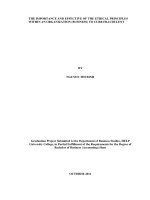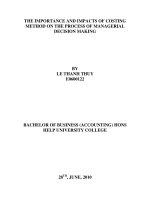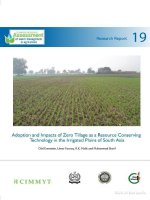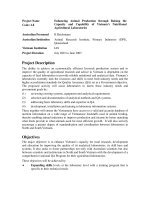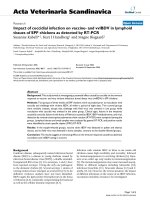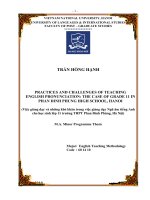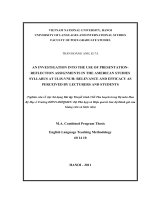Importance and capability of teaching leadership as perceived by beginning agricultural education teachers
Bạn đang xem bản rút gọn của tài liệu. Xem và tải ngay bản đầy đủ của tài liệu tại đây (1.31 MB, 159 trang )
Importance and Capability of Teaching Leadership as Perceived by Beginning
Agricultural Education Teachers
DISSERTATION
Presented in Partial Fulfillment of the Requirements for the Degree Doctor of Philosophy
in the Graduate School of The Ohio State University
By
Jon Christian Simonsen
Graduate Program in Agricultural and Extension Education
The Ohio State University
2010
Dissertation Committee:
Robert J. Birkenholz, Advisor
Joseph A. Gliem
Jeffrey E. King
Copyright by
Jon Christian Simonsen
2010
Abstract
We are surrounded by leadership influences that impact our daily lives and the
future will require numerous leaders possessing leadership knowledge, skills, and
dispositions. The teaching of leadership has an extensive tradition in secondary
agricultural education programs that can be traced back almost a century. Much of the
success in teaching leadership rests upon the secondary agricultural education teacher
providing the learning experience. The primary goal of agricultural education teacher
preparation programs is to develop highly qualified teachers in the subjects they are
expected to teach. Leadership topics are being taught in the formal instruction component
of secondary agricultural education programs. Thus, it is essential for agricultural
education teacher preparation programs to better understand the importance of teaching
leadership and the capability of agricultural education teachers to teach the leadership
topics. This information can then be used by administrators and faculty as they make
decisions about the design, implementation, and effectiveness of agricultural education
teacher preparation programs.
This descriptive research explored the importance of teaching leadership in
secondary agricultural education programs and the self-perceived capability of beginning
secondary agriculture teachers to teach leadership. First through third year agricultural
education teachers in Illinois, Indiana, Kentucky, Missouri, and Ohio were surveyed. The
researcher-developed data collection instrument was based on the National FFA
ii
Organization LifeKnowledge® resource materials. Respondents rated the importance and
self-perceived capability to teach 60 leadership topics. Data collected were used to:
describe the importance of teaching leadership topics, describe the capability to teach
leadership, calculate discrepancy scores, and to prioritize leadership topics.
Based on the data collected, it was determined that a majority of beginning
agricultural education teacher respondents had taken leadership coursework during their
post-secondary education and nearly one of five had taken more than three leadership
courses. Respondents reported that leadership topics were important to teach in secondary
agricultural education programs. Furthermore, the respondents perceived they were
capable of teaching leadership topics.
Agricultural education teacher preparation programs are encouraged to consider
leadership coursework in program requirements. This research revealed an extensive list
of important leadership topics that may overwhelm agricultural education teachers.
Therefore, it is recommended that efforts should be made to identify core leadership
knowledge, skills, and dispositions that should be taught in all secondary agricultural
education programs. Assessment of teacher capability to teach leadership topics should
be conducted periodically with teacher candidates and practicing agriculture teachers.
Based on assessment results, modifications to teacher preparation programs and
professional learning opportunities should be considered. As the teaching of leadership
continues to evolve, care should be taken to ensure that leadership development and
leadership education efforts are harmonious and build upon each other to provide the
knowledge, skills, and dispositions desired in future generations of leaders.
iii
Dedication
To Leon and Marcella Simonsen – my parents and true teachers – I Love You
iv
Acknowledgments
I thank my family, mentors, and the Good Lord for providing me support and guidance
throughout this educational journey.
The amount of sacrifice that my wife, Michelle, and our two boys, Nick and Carter, have
gone through during this process is humbling. To them, thank you and I love you more
than you will ever know. To mine and Michelle’s families, your support and prayers
through this journey has kept us focused and secure when we decided to move a 1,000
miles away.
Thank you to Dr. Robert J. Birkenholz for his patience and guidance throughout this
process. He has helped me to not only develop the knowledge and skills necessary to be a
part of post-secondary education but demonstrated the dispositions of a true educator in
all facets of life. Thank you to Dr. Jeffrey E. King and Dr. Joseph A. Gliem for being
integral parts of my educational journey, aiding in further developing my leadership
education understanding and honing my research abilities. Thank you to all the
professional faculty and staff that have supported and helped mentor me during this
educational journey. Thank you to the graduate student colleagues that I have
encountered over the years. There were times of frustration, doubt, and disagreement but
most of all there was celebration. I know our paths will continue to cross.
v
Dear Lord, thank you for allowing me and my family to embark upon this journey. There
were many questions along the way, but we know the answer in our hearts why we were
to take this journey. We are eternally grateful and ask for Your continued guiding hand in
our lives as we continue to serve You.
vi
Vita
December 24, 1972 ........................................Born, Superior, Nebraska
1996................................................................B.S. Agricultural Education
and Agricultural Economics
University of Nebraska – Lincoln
1997 - 2007 ....................................................Agricultural Education Instructor
Holdrege Public Schools
Holdrege, Nebraska
2008................................................................M.S. Agricultural and Extension Education
The Ohio State University
2007 to present ...............................................Graduate Teaching Associate
The Ohio State University
Publications
Simonsen, J. C., & Birkenholz, R. J. (In press). Leadership courses required in
agricultural teacher education programs. Journal of Agricultural Education.
Velez, J. J., Simonsen, J. C., Cano, J., & Connors, J. J. (In press). Teacher partnerships:
The use of peer facilitators in the college classroom. Journal of Agricultural
Education.
vii
Fields of Study
Major Field: Agricultural and Extension Education
viii
Table of Contents
Abstract ............................................................................................................................... ii
Dedication .......................................................................................................................... iv
Acknowledgments............................................................................................................... v
Vita.................................................................................................................................... vii
List of Tables ................................................................................................................... xiii
List of Figures .................................................................................................................. xiv
Chapter 1: Introduction ...................................................................................................... 1
Problem Statement .......................................................................................................... 6
Purpose of the Study ....................................................................................................... 8
Objectives ........................................................................................................................ 9
Definition of Terms ....................................................................................................... 10
Limitations of the Study ................................................................................................ 12
Basic Assumptions ........................................................................................................ 14
Chapter 2: Review of Literature ....................................................................................... 15
Theoretical Foundation ................................................................................................. 15
Leadership Theory......................................................................................................... 16
ix
Leadership Education .................................................................................................... 23
Post-Secondary Agricultural Leadership Education ..................................................... 27
Secondary Agricultural Leadership Education ............................................................. 30
Agriculture Teacher Preparation ................................................................................... 33
Teacher Self-Efficacy.................................................................................................... 36
Conceptual Framework ................................................................................................. 40
Chapter 3: Procedures ....................................................................................................... 41
Research Design ............................................................................................................ 41
Conceptual Model ......................................................................................................... 42
Research Objectives ...................................................................................................... 43
Population and Sampling .............................................................................................. 44
Instrumentation.............................................................................................................. 45
Data Collection .............................................................................................................. 47
Data Analysis ................................................................................................................ 49
Chapter 4: Results ............................................................................................................. 53
Data Collection .............................................................................................................. 54
Findings for Research Objective 1 ................................................................................ 57
Findings for Research Objective 2 ................................................................................ 61
Findings for Research Objective 3 ................................................................................ 71
x
Findings for Research Objective 4 ................................................................................ 82
Findings for Research Objective 5 ................................................................................ 88
Major Findings .............................................................................................................. 92
Summary ....................................................................................................................... 92
Chapter 5: Discussion ....................................................................................................... 94
Overview ....................................................................................................................... 94
Major Findings .............................................................................................................. 96
Discussion ..................................................................................................................... 97
Conclusions ................................................................................................................. 103
Implications ................................................................................................................. 107
Recommendations ....................................................................................................... 108
Suggestions for Further Research ............................................................................... 111
Summary ..................................................................................................................... 112
References ....................................................................................................................... 114
APPENDIX A – Panel of Experts .................................................................................. 123
APPENDIX B – Pre-Notification Letter......................................................................... 125
APPENDIX C – Cover Letter ......................................................................................... 127
APPENDIX D – Data Collection Instrument ................................................................. 130
APPENDIX E – First Email Reminder........................................................................... 139
xi
APPENDIX F – Second Email Reminder ...................................................................... 141
APPENDIX G – Final Email Reminder ......................................................................... 143
xii
List of Tables
Table 1. Demographic Characteristics of Beginning Agricultural Education Teachers ... 59
Table 2. States in Which Teachers Taught ....................................................................... 60
Table 3. Leadership Courses Taken During Teacher Preparation Program ..................... 61
Table 4. Perceived Level of Importance of Leadership Topics ........................................ 63
Table 5. Perceived Level of Capability to Teach Leadership Topics ............................... 73
Table 6. Mean Weighted Discrepancy Scores for Individual Leadership Topics ............ 83
xiii
List of Figures
Figure 1. Diagram of the Integrated Three-Component Agricultural Education Model .... 6
Figure 2. Conceptual Model of a Teacher’s Ability to Teach Leadership........................ 40
Figure 3. Conceptual Model of a Teacher’s Ability to Teach Leadership........................ 43
Figure 4. Modified Johari Window Classifying Leadership Topics by Importance and
Teacher Capability ............................................................................................................ 51
Figure 5. Modified Johari Window Classifying Leadership Topics by Importance and
Teacher Capability ............................................................................................................ 88
Figure 6. Leadership Topics Placed within a Modified Johari Window .......................... 89
Figure 7. Leadership Topics Identified within the Important and Capable Quadrant of a
Modified Johari Window .................................................................................................. 90
xiv
Chapter 1: Introduction
Leadership exhibited by individuals now and in the future will determine the path
of society. Leadership is valued by individuals, corporations, academic institutions, and
society to address issues (Northouse, 2010). “We are faced with immensely threatening
problems – terrorism, AIDS, drugs, depletion of the ozone layer, the threat of nuclear
conflict, toxic waste, the real possibility of economic disaster” (Gardner, 1995, p. 4).
Kouzes and Posner (1995) declared that now, more than ever, there is a need for
leadership to lead us to greatness. Astin, Astin, & Associates (2000) echoed similar
thoughts five years later when they wrote:
The list of problems is a long one: shaky race relations, growing economic
disparities and inequities, excessive materialism, decaying inner cities, a
deteriorating infrastructure, a weakening public school system, an
irresponsible mass media, declining civic engagement, and the increasing
ineffectiveness of government, to name just a few (p. 2).
Many of these same concerns and sentiments can be seen and heard today. Thus,
continuing a critical need and desire for leaders with new approaches to leadership in a
rapidly changing world (Komives, Lucas, & McMahon, 2007).
“Leadership is one of the most observed and least understood phenomena on
earth” (Burns, 1995, p. 9). Experts have defined leadership in a number of ways.
“Leadership is the process of influencing others to understand and agree about what
1
needs to be done and how to do it, and the process of facilitating individual and collective
efforts to accomplish shared objectives” (Yukl, 2006, p. 8). Northouse (2010) suggests
the essential elements to leadership include that leadership is a process, involves
influence, occurs within a group context, and involves goal attainment. Leadership is “. . .
the capacity to influence others by unleashing their power and potential to impact the
greater good [italics in original text]” (Blanchard, 2007, p. xix). “To an extent, leadership
is like beauty: it’s hard to define, but you know it when you see it” (Bennis, 1989, p. 1).
Author John C. Maxwell (1993) concluded that leadership is influence.
The saying that ‘leaders are born and not made’ has been heard for many years.
Much of this thought was based upon a belief that leaders possessed special genetic traits
that were the origin of their leadership ability (Komives et al., 2007). This early view of
trait leadership has given way to behavioral and contingency theories (Chemers, 1995).
More recently, perspectives such as transformational, servant, authentic, and relational
leadership have surfaced in the leadership literature (Komives et al., 2007). Over that
time, a paradigm shift occurred in which it was believed that leadership knowledge and
skills were not simply inherent, but could be learned (Eich, 2008; Dubrin, 2001; Komives
et al., 2007; Wren, 1995; Yukl, 2006).
Leadership is not a gene, and it is not a secret code that cannot [sic] be
deciphered by ordinary people. The truth is that leadership is an
observable set of skills and abilities that are useful whether one is seated
in the executive suite or standing on the front line on Wall Street, Main
Street, or College Avenue (Posner, 2009, p. 1-2).
2
The potential for leadership exists in every student and can be developed through focused
educational programs (Cress, Astin, Zimmerman-Oster, & Burkhardt, 2001; ZimmermanOster & Burkhardt, 1999). Participation in leadership programs has been shown to have a
positive impact on personal development, civic responsibility, multicultural awareness,
understanding values, and other outcomes connected to leadership development (Cress et
al., 2001).
We are surrounded by leadership influences that impact our daily lives and the
future will require numerous leaders. Gardner (1995) discussed this need by stating,
“When one considers all the towns and city councils, corporations, government agencies,
unions, schools and colleges, churches, professions, and so on, the number must be high”
(p. 7). The call to leadership is for everyone. Teaching and learning about leadership at
all educational levels is vital to the future of society. Thus, it is important that teachers
who are called upon to teach leadership are prepared and capable of fulfilling this
important responsibility. Since leadership is taught in secondary agricultural education
programs (Morgan & Rudd, 2006), it is important that agriculture teachers possess the
knowledge and skills needed to fulfill that professional role and responsibility.
The teaching of agriculture in North America can be traced back to Native
Americans who transferred the practice of agriculture from generation to generation
(Simonsen, 2008). Thomas Jefferson envisioned the United States of America as a nation
that would gain worldwide respect, power, and prosperity based upon agricultural wealth
and wrote about potential courses of agricultural study and agrarian culture (Grant, Field,
Green, & Rollin, 2000).
3
Structured teaching of agricultural subjects at the secondary level began in the
1800’s to instill an understanding of the science of agriculture in students and to prepare
those students for employment in agriculture. During that era, the Land Grant Acts of
1862 and 1890, often referred to as the Morrill Acts, established higher education
throughout the United States in the form of a land grant system. The mission of the land
grant system was to provide higher education in the areas of agriculture and mechanical
arts for the common individual (Zimdahl, 2003).
Legislation enacted in 1917 titled the National Vocational Education Act, more
commonly referred to as the Smith-Hughes Act, provided federal funds to officially
implement formal agricultural education instruction across the nation. The legislation
provided monies to support secondary programs, teacher preparation, and teacher
educators (Camp & Crunkilton, 1985).
Agricultural teacher preparation programs across the nation have been faced with
the task of preparing teachers for secondary agricultural education since the early 1900s,
even before the Smith-Hughes Act. Teacher preparation programs are responsible for
producing knowledgeable and highly qualified candidates for state licensure, leading to
success in the teaching profession (Simonsen, 2008). The No Child Left Behind (NCLB)
legislation defined “highly qualified” teachers as individuals who meet three criteria: (1)
achieve a bachelor degree or higher in the subject taught; (2) acquire state teacher
certification; and (3) exhibit knowledge in the subjects taught (United States Department
of Education, 2006).
4
Secondary agricultural education programs encompass a diverse array of subject
and content areas within agriculture. Subjects may include, but are not limited to, areas
such as agricultural mechanics, agricultural production, animal science, biotechnology,
and horticulture (Talbert, Vaughn, & Croom, 2006). These subject areas are presented not
only through didactic instruction in traditional classroom settings, but also throughout an
integrated three-component agricultural education model: classroom and laboratory
instruction, supervised agricultural experience, and agricultural youth organization
participation (Phipps & Osborne, 1988). Figure 1 provides a graphical illustration of the
model where classroom and laboratory instruction is titled Formal Instruction, supervised
agricultural experience titled Supervised Experience, and agricultural youth organization
participation titled FFA (Croom, 2008). Preparing highly qualified, effective teachers to
deliver the diverse array of subject matter content and apply the integrated threecomponent model has been a major focus of agricultural education teacher preparation
programs.
5
Formal
Instruction
Supervised
Experience
FFA
Figure 1. Diagram of the Integrated Three-Component Agricultural Education Model
(Croom, 2008).
Problem Statement
Teaching leadership in secondary agricultural education programs has evolved
over time. An extensive tradition in developing the leadership skills of youth in
agriculture and secondary agricultural education programs can be traced back over a
century. Youth clubs began in the early 1900’s which focused on agricultural
commodities such as poultry, soybeans, and corn. The clubs strived to build leadership
skills of youth (Hillison, 1993) by allowing for youth with similar interests to interact
(Hillison & Bryant, 2001). The Future Farmers of America (FFA) was modeled after the
aforementioned clubs and was officially chartered in 1928. Subsequently, FFA became
part of the integrated, three-component agricultural education model.
Since its inception, student participation in the FFA has been the primary context
for secondary agricultural education students to develop leadership skills (Simonsen,
6
2008). However, not all secondary agriculture students have participated in the
educational experiences available through the FFA; thus failing to realize the potential
benefits of leadership knowledge and skill development (Morgan & Rudd, 2006). To
meet this challenge, some secondary agricultural education programs have incorporated
the teaching of leadership topics into the instructional program. Leadership topics have
been integrated within technical agriculture courses in some programs, whereas other
programs have offered separate leadership courses with the goal of educating all students
in the subject area of leadership (Simonsen, 2008). Such programmatic adaptations have
been based upon the belief that many students in the future will be presented with
opportunities to fill leadership positions as productive citizens within their communities.
Students with an understanding of leadership through education and training will be
better equipped to fulfill those leadership roles and responsibilities (Ricketts & Rudd,
2002).
Leadership topics are being taught in the formal classroom instruction component
of secondary agricultural education programs (Morgan & Rudd, 2006). Teacher
preparation programs therefore need to include leadership coursework to prepare future
teachers in the subject matter content they will be expected to teach. Previous research
has found that content area coursework comprises slightly over 40% of the average
teacher licensure program in agricultural education (Boone, 2002). Yet, less than half of
the post-secondary agricultural teacher preparation programs require coursework in
leadership (Simonsen, 2008). Furthermore, using a leadership knowledge assessment
based on the National FFA LifeKnowledge® precepts, secondary agricultural education
7
instructors’ possess only a moderate amount of leadership knowledge (Morgan & Rudd,
2006). Additional research was recommended to determine if secondary agricultural
education teachers were prepared to teach the content area of leadership (Simonsen,
2008) and to determine the common base of leadership content knowledge that secondary
agricultural education teachers possessed (Morgan, 2004).
The goal of teacher preparation programs is to develop highly qualified and
effective teachers in the subjects and content areas they are expected to teach. Previous
research in agricultural education (Morgan, 2004) identified leadership topics taught
within the formal classroom setting in agricultural education. However, teacher educators
need to know the leadership topics that are important to be taught in secondary
agricultural education programs. In addition, there was a need to determine the perceived
capability of agricultural education teachers to teach the important leadership topics.
Knowing more about the importance of leadership topics and the capability of
agricultural education teachers to teach those leadership topics will provide information
that can be used by administrators and faculty to make decisions about the design,
implementation, and effectiveness of agricultural education teacher preparation programs.
Purpose of the Study
The purpose of this study was to describe the perceptions of beginning
agricultural education teachers regarding the importance of teaching leadership topics in
secondary agricultural education programs. This study also was conducted to describe
beginning agricultural education teachers’ perceptions regarding their capability to teach
8
leadership topics. Findings from this study provide a basis for curriculum development
and program planning decisions pertaining to effectively preparing secondary agricultural
education teachers to teach leadership. Teachers should know, understand, and be able to
demonstrate the content area that they teach (American Association for Agricultural
Education, 2001; Interstate New Teacher Assessment and Support Consortium, 2008;
National Council for Accreditation of Teacher Education, 2008; Ohio Department of
Education, 2007; Teacher Education Accreditation Council, 2006). This study provides
information which can be used by university administrators and faculty to determine the
perceived level of importance of teaching leadership topics within secondary agricultural
education programs and if beginning agricultural education teachers perceive they are
capable of teaching leadership. Information from this study can then be utilized by
university administrators and faculty to modify agriculture teacher preparation programs
and courses accordingly.
Objectives
Although leadership education and leadership development are incorporated
throughout the Agricultural Education Model (see Figure 1); this study focused on the
formal instruction component in secondary agricultural education programs. The
following research objectives were developed to guide this study:
1.
Describe the demographic characteristics of beginning agricultural
education teachers.
9
2.
Describe the importance of leadership topics as perceived by beginning
agricultural education teachers.
3.
Describe the perceived capability of beginning agricultural education
teachers to teach leadership topics.
4.
Determine the discrepancy between leadership topic importance and the
capability to teach leadership topics as perceived by beginning agricultural teachers.
5.
Prioritize leadership topics by importance and teacher capability based on
beginning agricultural education teachers’ perceptions.
Definition of Terms
Agricultural Teacher Education Program – post-secondary program that prepares
candidates to meet licensure requirements for secondary agricultural education teaching
Beginning Agricultural Education Teacher – a secondary agricultural education
instructor with one to three years of teaching experience
Leadership - a process whereby an individual influences a group of individuals to achieve
a common goal (Northouse, 2010)
10



